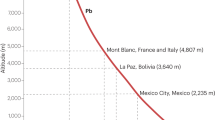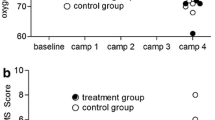Abstract
A relationship exists between exposure to high altitude and increased coagulability. Mean platelet volume is a parameter of platelet functions and may be a marker for increased platelet aggregability. The aim of this study was to compare the mean platelet volumes and platelet counts in patients who experienced an acute coronary event at moderately high altitude and at sea altitude. Four hundred and one patients who experienced an acute coronary event were enrolled, of them 211 were born and had been living at the sea level, while 190 were born and had been living at high altitude (at least 2,000 m above the sea level). Patients were compared regarding the mean platelet volumes and platelet counts. The mean platelet volumes were significantly higher in patients living in high altitude (P = 0,001). No statistically significant differences were found among the groups regarding the platelet counts. As a result, this increased MPV values in highlanders who experienced an acute coronary event may reflect increased platelet aggregability.


Similar content being viewed by others
References
Chohan IS (1984) Blood coagulation changes in high altitude. Defence Sci J 34:360–362
Singh I, Chohan IS (1972) Abnormalities of blood coagulation at high altitude. Int J Biometerol 16:283–287
Maher JT, Levine H, Cyberman A (1976) Humana coagulation abnormalities during acute exosure to hyobaric hyoxia. J Allied Physiol 41:702–711
Hudson JG, Bower AL, Naira P (1999) The effect of high altitude on platelet counts, thrombopoietin and erythropoietin levels in young Bolivian Armymen visiting the Andese. Int J Biometerol 43:85–90
Singh I, Chohan IS (1972) Blood coagulation changes at high altitude predisposing to pulmonary hyertension. Br Heart J 34:611–616
Genton E, Ross AM, Takeda YA, Vogel JH (1970) Alterations in blood coagulation at high altitude. In: Vogel JHK (ed) Hypoxia, high altitude and the heart, advances in cardiology, 3rd edn. Karger, Basel, pp 32–37
Ross R (1999) Atherosclerosis: an inflammatory disease. N Engl J Med 340:115–126
Smith NM, Pathansali R, Bath PM (1999) Platelets and stroke. Vasc Med 4:165–172
Endler G, Klimesch A, Sunder-Plassmann H et al (2002) Mean platelet volume is an independent risk factor for myocardial infarction but not for coronary artery disease. Br J Haematol 117:399–404
Martin JF, Bath PM, Burr ML (1991). Influence of platelet size on outcome after myocardial infarction. Lancet 338:1409–1411
Cannon CP, Braunwald E (2005) Unstable angina and non-st elevation myocardial infarction. In: Braunwald E, Zipes D, Libby P (eds) Heart disease. A textbook cardiovascular medicine, 7th edn. W.B. Saunders, Philadelphia, pp 1243–1267
Braunwald E, Antman EM, Beasley JW, Califf RM, Cheitlin MD et al (2002) American College of Cardiology/American Heart Association Task Force on practice guidelines (Committee on the management of patients with unstable angina). ACC/AHA guideline update for the management of patients with unstable angina and non-ST-segment elevation myocardial infarction—2002: summary article: a report of the American College of Cardiology/American Heart Association Task Force on Practice Guidelines (Committee on the management of patients with unstable angina). Circulation 106:1893–1900
Cay S, Biyikoglu F, Cihan G, Korkmaz S (2005) Mean platelet volume in patients with cardiac syndrome X. J Thromb Thrombolysis 20(3):175–178
Dalby Kristensen S, Milner PC, Martin JF (1988) Bleeding time and platelet volume in acute myocardial infarction a 2 year follow-up study. Thromb Haemost 59:353–356
Bitigen A, Tanalp AC, Elonu OH, Karavelioglu Y, Ozdemir N (2007) Mean platelet volume in patients with isolated coronary artery ectasia. J Thromb Thrombolysis 24(2):99–103
Jakubowski JA, Adler B, Thompson CB et al (1985) Influence of platelet volume on the ability of prostacyclin to inhibit platelet aggregation and the release reaction. J Lab Clin Med 105:271–276
Rao AK, Goldberg RE, Walsh PN (1984) Platelet coagulant activities in diabetes mellitus. Evidence for relationship between platelet coagulant hyperactivity and platelet volume. J Lab Clin Med 103:82–92
Mathur A, Robinson MS, Cotton J et al (2001) Platelet reactivity in acute coronary syndromes: evidence for differences in platelet behaviour between unstable angina and myocardial infarction. Thromb Haemost 85:989–994
Martin JF, Bath PM, Burr ML (1991) Influence of platelet size on outcome after myocardial infarction. Lancet 338:1409–1411
Singh I (1973) Pulmonary hypertension in new arrivals at high altitude. Proceedings of World Health Organisation meeting on primary pulmonary hypertension. WHO, Geneva, pp 12–14
Presti B, Berthrong M, Sherwin RM (1990) Chronic thrombosis of pulmonary arteries. Hum Pathol 21:601–602
Anand AC, Saha A, Seth AK, Chopra GS, Nair V, Sharma V (2005) Symptomatic portal system thrombosis in soldiers due to extended stay at extreme high altitude. Hepatology 20:777–778
Al-Huthi MA, Raja’a YA, Al-Noami M, Abdul Rahman AR (2006) Prevalence of coronary risk factors, clinical presentation, and complications in acute coronary syndrome patients living at high vs. low altitudes in Yemen. MedGenMed 7;8:28
Jha SK, Anand AC, Kumar N, Adya CM (2002) Stroke at high altitude: Indian experience. High Alt Med Biol 3:21–27
Valkila EH, Salenius JP, Koivula TA (1994) Platelet indices in patients with occlusive carotid artery disease. Angiology 45:361–365
Halbmayer WM, Haushofer A, Radek J, Schön R, Deutsch M, Fischer M (1995) Platelet size, fibrinogen and lipoprotein(a) in coronary heart disease. Coron Artery Dis 6:397–402
Ramirez G, Bittle PA, Rosen R et al (1999). High altitude living: genetic and environmental adaptation. Aviat Space Environ Med 70:73–81
Domej W, Schwaberger G (2000) Respiratory adaptation to altitude and risk factors due to respiratory illnesses in German. Wien Med Wochenschr 150:163–168
Beall CM, Brittenham GM, Strohl KP et al (1998) Hemoglobin concentration of high-altitude Tibetans and Bolivian Ayamara. Am J Phys Anthropol 106:385–400
Wu T, Wang X, Wei C et al (2005) Hemoglobin levels in Qinghai-Tibet: different effects of gender for Tibetans vs. Han. J Appl Physiol 98:598–604
Gagnon DR, Zhang TJ, Brand FN, Kannel WB. (1994) Hematocrit and the risk of cardiovascular disease the Framingham study: a 34-year follow-up. Am Heart J 127:674–682
Heinicke K, Prommer N, Cajigal J, Viola T, Behn C, Schmidt W, (2003) Long-term exposure to intermittent hypoxia results in increased hemoglobin mass, reduced plasma volume, and elevated erythropoietin plasma levels in man. Eur J Appl Physiol 88:535–543
Wolf RF, Peng J, Friese P, Gilmore LS, Burstein SA, Dale G (1997) Erythropoietin administration increases production and reactivity of platelets in dogs. Thromb Haemost 78:1505–1508
Sharpe PC, Desai ZR, Morris TC (1994) Increase in mean platelet volume in patients with chronic renal failure treated with erythropoietin. J Clin Pathol 47:159–161
Butkiewicz A, Kemona H, Dymicka-Piekarska V, Bychowski J (2003) Betathromboglobulin and platelets in unstable angina. Kardiol Pol 58:449–455
Bath PM, Butterworth RJ (1996) Platelet size: measurement, physiology and vascular disease. Blood Coagul Fibrinolysis 7:157–161
Author information
Authors and Affiliations
Corresponding author
Rights and permissions
About this article
Cite this article
Alper, A.T., Sevimli, S., Hasdemir, H. et al. Effects of high altitude and sea level on mean platelet volume and platelet count in patients with acute coronary syndrome. J Thromb Thrombolysis 27, 130–134 (2009). https://doi.org/10.1007/s11239-007-0159-9
Received:
Accepted:
Published:
Issue Date:
DOI: https://doi.org/10.1007/s11239-007-0159-9




